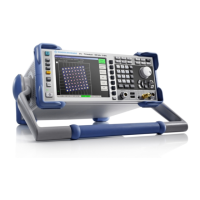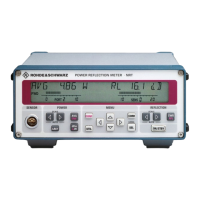R&S FSH Measuring the occupied bandwidth
1309.6275.12 4.43 E-2
Selecting a standard
T
he R&S FSH offers a default for measuring the occupied bandwidth for different standards. It is also
possible to define and save user-specific configurations.
Press the STANDARD softkey.
A table with the available standards opens.
Using the rotary knob or the cursor keys, select the
appropriate standard.
Confirm your selection with the ENTER key or the
STANDARD softkey.
The selected standard is set. The optimal span,
resolution bandwidth, video bandwidth, sweep time
and detector for the standard are selected
automatically.
The following should be noted when changes to the settings are made:
• The span is always coupled to the channel bandwidth (CHANNEL BW). When changes are made,
the R&S FSH automatically sets the appropriate span (= 5 x channel bandwidth).
• The resolution bandwidth should be between 1% and 4% of the channel bandwidth. This ensures
that the occupied bandwidth is measured with high accuracy.
• The video bandwidth must be at least three times the resolution bandwidth. This prevents incorrect
results due to the compression of signal peaks by the video filter.
• The RMS detector is recommended. This ensures that the power measurement is always correct
irrespective of the waveform being investigated.
• The sweep time must be set so that the result is stable. If the sweep time is increased, the
R&S FSH also increases the integration time for the RMS detector and thus ensures more stable
measured values.
Using the R&S FSH4View control software, additional standards can be generated and permanently
loaded into the R&S FSH. You can also delete the factory-set standards provided in the instrument if
you do not need them. The R&S FSH then offers only the standards you require.
Setting the reference level
When selecting the reference level, ensure that the R&S FSH is not overdriven. As the power is
measured with a resolution bandwidth that is small in comparison with the signal bandwidth, the
R&S FSH may still be overdriven even though the trace is within the measurement diagram. To prevent
the R&S FSH from being overdriven, the signal can be measured at the largest resolution bandwidth
possible using the peak detector. If this setting is selected, the trace may not exceed the reference
level.
To simplify operation and to prevent incorrect measurements, the R&S FSH has an automatic routine
for setting the reference level.

